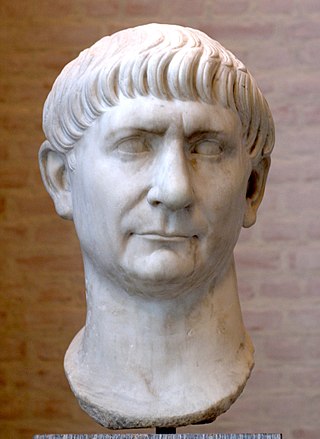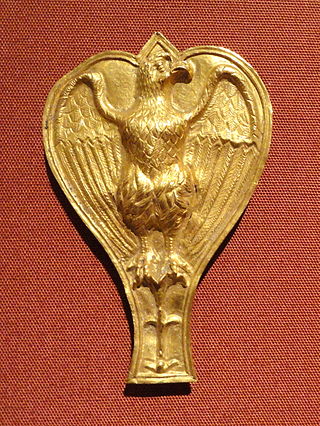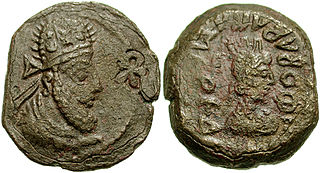
Attambelos VII was a king of Characene, a vassal state of the Parthians and important trading port. His short reign lasted from 113/4 to 116/7 AD and was spent mostly contending with the Roman invasion under Trajan.

Attambelos VII was a king of Characene, a vassal state of the Parthians and important trading port. His short reign lasted from 113/4 to 116/7 AD and was spent mostly contending with the Roman invasion under Trajan.
Like most kings of Characene he is primarily known from numismatic sources, [1] in his case from few a few bronze coins dated 113/114AD.
In 114 or 115 the Emperor Trajan took the Parthian capital city of Ctesiphon and then moved with a fleet of 50 ships to the Characene state on the Persian Gulf. Attambelos VII surrendered to Trajan around 116/17AD [2] who received the temporary submission of Attambelos, as the ruling prince in Characene. [3]
Despite the overwhelming victory, the Romans did not hold Mesopotamia for long, with the area being abandoned shortly after the death of Trajan. However, the fate of Attambelos VII during this time is unknown. The next King of Characene is not heard of until 131AD. [4] [5] His successor was Meredates son of Pakoros (II), King of the Parthian Empire who had himself been king of Characene from 80 to 101/02, a generation earlier. Meredates was eventually ousted by his cousin Vologases IV, from a rival branch of the Parthian royal house, indicating a time of weakness within both the Parthian royalty and the local Characene rulers, a weakness made much worse by the opportunistic invasion by Trajan. This weakening in royal power may also be indicated by the quality of Attambelos coinage, which is bronze, unlike the silver Tetradrachm coinage of his predecessors and may account for the lapse in coinage after Attambelos VII time.
Attambelos VII coinage is also significant as his are the last Characene coinage that have a truly Greek style. From the invasion of Trajan the influence of Greek style becomes noticeably less.

Trajan was Roman emperor from 98 to 117 AD, the second of the Five Good Emperors of the Nerva–Antonine dynasty. He was a philanthropic ruler and a successful soldier-emperor who led the Roman Empire to its greatest territorial extent by the time of his death. He was given the title of optimus by the Roman Senate.

The 110s was a decade that ran from January 1, AD 110, to December 31, AD 119.

Gaius Julius Antiochus IV Epiphanes, the last king of Commagene, reigned between 38 and 72 as a client king to the Roman Empire. The epithet "Epiphanes" means "the Glorious".

Vologases III was king of the Parthian Empire from 110 to 147. He was the son and successor of Pacorus II.

Osroes I was a Parthian contender, who ruled the western portion of the Parthian Empire from 109 to 129, with a one-year interruption. For most of his reign he contended with the rival king Vologases III who was based in the eastern provinces. In 116, Osroes I was briefly ousted from his throne at Ctesiphon during an invasion by Roman emperor Trajan, who installed Osroes' son, Parthamaspates. After Trajan's death the following year, Osroes I's rule was reinstated by the Parthian nobility. In 129, he was removed from power by Vologases III.

Vologases IV was King of Kings of the Parthian Empire from 147 to 191. He was the son of Mithridates V. Vologases spent the early years of his reign re-asserting Parthian control over the Kingdom of Characene. From 161 to 166, he waged war against the Roman Empire; although initially successful, conquering Armenia and Syria, he was eventually pushed back, briefly losing control of the Parthian capitals of Seleucia and Ctesiphon to the Romans. The Romans suffered heavy losses from a plague erupting from Seleucia in 166, forcing them to withdraw. The war ended soon afterward, with Vologases losing most of northern Mesopotamia to the Romans. He died in 191 and was succeeded by his son Vologases V.

An aquila was a prominent symbol used in ancient Rome, especially as the standard of a Roman legion. A legionary known as an aquilifer, the "eagle-bearer", carried this standard. Each legion carried one eagle.

The Kitos War was one of the major Jewish–Roman wars (66–136). The rebellions erupted in 115 when most of the Roman armies were fighting Trajan's Parthian War on the eastern border of the Roman Empire. Major uprisings by Jews in Cyrenaica, Cyprus and Egypt spiralled out of control, resulting in a widespread slaughter of the remaining Roman garrisons and Roman citizens by Jewish rebels.

Characene, also known as Mesene (Μεσσήνη) or Meshan, was a kingdom founded by the Iranian Hyspaosines located at the head of the Persian Gulf mostly within modern day Iraq. Its capital, Charax Spasinou, was an important port for trade between Mesopotamia and India, and also provided port facilities for the city of Susa further up the Karun River. The kingdom was frequently a vassal of the Parthian Empire. Characene was mainly populated by Arabs, who spoke Aramaic as their cultural language. All rulers of the principality had Iranian names. Members of the Arsacid dynasty also ruled the state.
Polemon I Pythodoros was the Roman Client King of Cilicia, Pontus, Colchis and the Bosporan Kingdom. Polemon was the son and heir of Zenon and possibly Tryphaena. Zenon and Polemon adorned Laodicea with many dedicated offerings.

Relations between the Roman and Iranian states were established c. 92 BC. It was in 69 BC that the two states clashed for the first time; the political rivalry between the two empires would dominate much of Western Asia and Europe until 628. Initially commencing as a rivalry between the Parthians and Rome, from the 3rd to mid-7th centuries the Roman Empire and its rival Sassanid Persia were recognized as two of the leading powers in the world.
The Arsacid dynasty, called the Arshakuni in Armenian, ruled the Kingdom of Armenia from 12 to 428. The dynasty was a branch of the Arsacid dynasty of Parthia. Arsacid kings reigned intermittently throughout the chaotic years following the fall of the Artaxiad dynasty until 62, when Tiridates I, brother of Parthian King Vologases I, secured Arsacid rule in Armenia as a client king of Rome. However, he did not succeed in establishing his line on the throne, and various princes of different Arsacid lineages ruled until the accession of Vologases II, who succeeded in establishing his own line on the Armenian throne, which ruled the kingdom until its abolishment by the Sasanian Empire in 428.

The Parthian Empire, also known as the Arsacid Empire, was a major Iranian political and cultural power in ancient Iran from 247 BC to 224 AD. Its latter name comes from its founder, Arsaces I, who led the Parni tribe in conquering the region of Parthia in Iran's northeast, then a satrapy (province) under Andragoras, who was rebelling against the Seleucid Empire. Mithridates I greatly expanded the empire by seizing Media and Mesopotamia from the Seleucids. At its height, the Parthian Empire stretched from the northern reaches of the Euphrates, in what is now central-eastern Turkey, to present-day Afghanistan and western Pakistan. The empire, located on the Silk Road trade route between the Roman Empire in the Mediterranean Basin and the Han dynasty of China, became a center of trade and commerce.

Charax Spasinu, also called Charax Spasinou, Charax Pasinu, Spasinu Charax, Alexandria or Antiochia in Susiana, was an ancient port at the head of the Persian Gulf in modern day Iraq, and the capital of the ancient kingdom of Characene.
The Roman–Parthian Wars were a series of conflicts between the Parthian Empire and the Roman Republic and Roman Empire. It was the first series of conflicts in what would be 682 years of Roman–Persian Wars.
Romans in Persia is related to the brief invasion and occupation of western and central areas of Parthia by the Romans during their empire. Emperor Trajan was even temporarily able to nominate a king of western parts of Parthia, Parthamaspates, as ruler of a Roman "client state" in Parthia.
Attambelos may refer to the following kings of the Parthian vassal state of Characene:

Meredates was a Parthian prince who ruled the state of Characene, a vassal of the Parthian Empire and important trading port, which he ruled from c. 131 to 150/151.

Julius Caesar's planned invasion of the Parthian Empire was to begin in 44 BC, but the Roman dictator's assassination that year prevented the invasion from taking place.